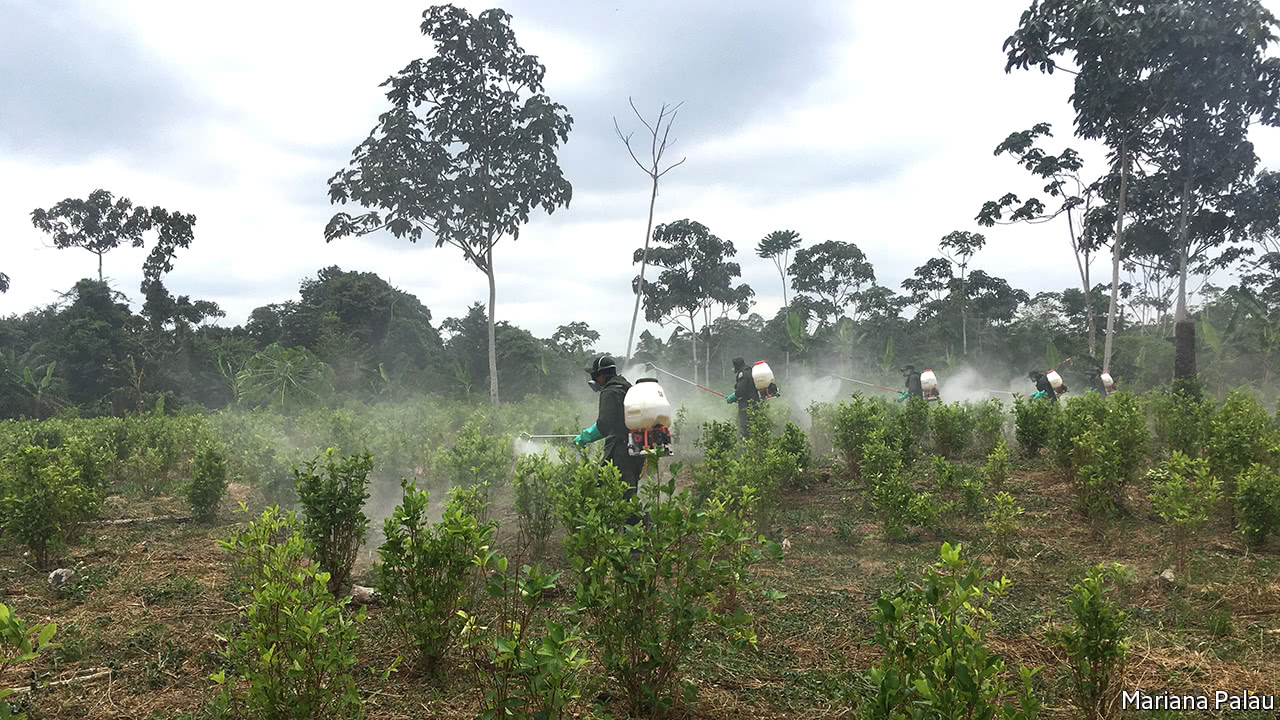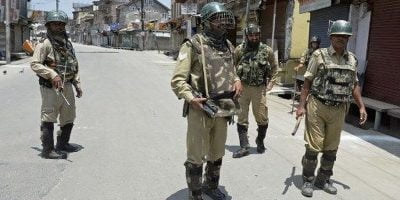
JUST one road connects Tumaco, the second-busiest port on Colombia’s Pacific coast, to the rest of the country. Beyond its verges are fields of coca bushes, many of them cultivated by poor people. Yuley Alexandra Ruano’s crop grows behind a beauty parlour she owns on a patch of land she does not. It is fringed by yucca, plantains and a rotting cacao tree. She and her neighbours have signed up to the government’s “comprehensive programme for illicit crop substitution” (PNIS), whose aim is to replace the coca with a profitable legal crop. But bureaucracy moves slowly. Ms Ruano has yet to see new seeds or the money promised by the government to help with the switch.
From her salon in the department of Nariño, she can see that the government is pursuing with more energy the other part of its anti-coca strategy, forced eradication. Every day a Black Hawk helicopter passes, bearing police to a jungle camp in Alto Mira y Frontera (see map). Their mission is to kill the bushes, by uprooting them or by spraying them with herbicide. The government wants to eradicate by force 65,000 hectares (160,000 acres) of coca this year.
The two approaches are supposed to complement each other. The crop-substitution strategy is set out in a peace accord that in 2016 ended more than 50 years of war between the government and the FARC, a leftist guerrilla group. It is part of a broader project to bring stability and better living standards to swathes of the countryside once controlled by the FARC, which has now become a political party. The government says it reserves forced eradication for industrial-scale plantations controlled by large drug gangs, and for farmers who refuse to participate in crop substitution.
But things are not going to plan. Coca cultivation surged in anticipation of the peace deal, from 96,000 hectares to 146,000 in 2016. Farmers planted more because they expected cash from the government to switch to something else. Voluntary substitution is progressing painfully slowly. That is partly because the government has not complemented it with a programme to build roads rapidly and provide services in coca-growing areas.
Some areas vacated by the FARC have been taken over by the ELN, a smaller guerrilla group; drug gangs such as the “Gaitanista Self-Defence Forces”, which has its origins in a right-wing paramilitary group; and FARC members who rejected the peace agreement. In January Colombia’s president, Juan Manuel Santos, suspended peace talks with the ELN after a series of bombings that killed seven policemen.
Armed groups also target small-scale growers of coca who want to switch crops. Last month in Caquetá, a southern department, ex-members of the FARC forced six officials of the UN Office on Drugs and Crime (UNODC) out of their cars and stole their GPS devices and mobile phones. The agency says the assault was an attempt to stop crop-substitution in that area.
The jump in coca production brought pressure from the United States. In September last year Donald Trump said he might decertify Colombia as a partner in the fight against drugs, putting in jeopardy some of the $390m in American aid Colombia receives. In February this year he threatened to cut aid to drug-exporting countries that are “laughing” at the United States. These warnings stirred traumatic memories of decertification in 1996 and 1997, when Colombia seemed to be a failing state.
Many Colombians are nearly as worried about coca as Mr Trump. They judge the success of the peace deal by the number of hectares given over to the crop, says Hernando Zuleta, director of the Centre for Studies on Security and Drugs at the University of the Andes in Bogotá. That is because the cocaine trade financed the FARC.
This is stirring up an election season already roiled by debate over corruption and the economy. Colombia is to elect a new congress on March 11th and a new president on May 27th. The contests pit supporters of the peace agreement against its foes. The agreement is unlikely to be reversed. So the argument has shifted to proxy issues, including the coca surge. Peace-deal sceptics cheer on forced eradication; pro-deal politicians back crop substitution.
Rafael Pardo, the government’s post-conflict “high commissioner”, thinks peace is unsustainable unless the government solves the coca problem. That is not because the FARC will return to war, but because coca crops “will always feed a market that is accompanied by violence”, he says. Small-scale coca-growers, caught between the security forces and the drug gangs, are among the most vulnerable to it.
Nowhere is Colombia’s many-sided drug war more intense than in Tumaco. It has 23,000 hectares of coca fields, more than any other municipality. Nariño, the department of which Tumaco forms a part, is a focal point of fighting among armed groups for control of the drug trade. The government sent 2,000 more troops to Tumaco in January to contain the violence.
Under pressure from Colombian voters, and perhaps the United States, the security forces uproot fields that are supposed to be set aside for voluntary crop substitution. That provokes clashes with small-scale coca-growers. Last year peasants angry about forced eradication blocked roads in Nariño and other regions for days. Members of an eradication group that took off from Tumaco killed seven unarmed protesters in October.
Since then, riot police have joined the missions. They are tension-filled. In a Black Hawk circling a coca field just outside Alto Mira y Frontera, a police officer spots three motorbikes speeding towards it. He suspects their drivers are farmers intent on protecting their crops. As the chopper lands, police jump out, to fumigate and depart before a confrontation can occur. A police commander says anyone who interferes risks being sprayed with glyphosate, even though Mr Santos, deeming the herbicide dangerous, banned aerial spraying in 2015. This month a group of farmers detained 14 riot police for a day in the area.
Such disputes are not supposed to happen. The PNIS is Colombia’s first large-scale attempt to deal with coca cultivation as a problem of development rather than a crime. Small farmers like Ms Ruano are supposed to get seeds for alternative crops, such as cacao, expert advice on planting them and a stipend of 1m pesos ($350) a month for a year. Nearly 30,000 families are benefiting from the programme.
But that is just a quarter of the families that have signed collective agreements, which is just the first step towards qualifying for help. The process is slow by design. UNODC has to verify that the acreage covered by collective agreements is accurate before the PNIS can sign individual ones. Farmers’ mistrust of the state, which was absent from coca-growing areas until recently, and the role given to the FARC by the peace agreement in co-ordinating crop substitution also slow things down, says Juan Carlos Garzón of Fundación Ideas para la Paz, an NGO.
While the PNIS process inches forward, the armed forces (including the police) exceeded their goal of eradicating 50,000 hectares by the end of 2017. The offensive has at least placated the United States. In Bogotá on February 6th Rex Tillerson, the secretary of state, praised Colombia’s progress but added a warning. “We need to see…the number of acres or hectares under cultivation going down,” he said.
The successes may be short-lived. UNODC estimates that growers replant 30% of the area uprooted on average. More important, the government has not made much progress in areas controlled by organised armed groups. As a result, the coca-growing area might well have expanded last year, UNODC says.
It will be up to the next president and congress to determine the balance between helping coca-growers and uprooting crops. Candidates on the left, such as Gustavo Petro, a former mayor of Bogotá, favour the voluntary approach. Conservatives such as Germán Vargas Lleras, a former vice-president, would resume aerial spraying. None of the main right-of-centre candidates has given much support to crop substitution. Unless Colombia’s next president gives stronger backing to the voluntary approach, a Black Hawk could soon land on Ms Ruano’s doorstep.
source:-.economist


